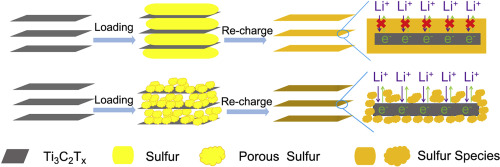Energy Storage Materials ( IF 18.9 ) Pub Date : 2019-12-25 , DOI: 10.1016/j.ensm.2019.12.036 Tianyu Lei , Yin Hu , Wei Chen , Weiqiang Lv , Yu Jiao , Xuepeng Wang , Xiaoxue Lv , Yichao Yan , Jianwen Huang , Junwei Chu , Chaoyi Yan , Chunyang Wu , Xianfu Wang , Weidong He , Jie Xiong

|
High-specific-area host materials have been widely used in lithium-sulfur (Li-S) batteries to trap ploysulfides for high sulfur utilization and excellent operation stability. However, uncontrollable deposition of non-conductive Li2S on host materials tends to occur on the high-loading hosts, causing disastrous surface passivation during the long-term operation. One effective way to tackle this problem is to control the nucleation and growth of sulfur species during cycling by engineering the structure of electrodeposited insulating Li2S to generate open channels for charge transport. In this work, we report a rationally designed porous structure sulfur cathode with homogeneous sulfur loading by incorporating [email protected] into the interlayers of highly conductive Ti3C2Tx, in which the backbone of the polyisoprene and the interlayers of Ti3C2Tx support the porous structure sulfur species, and the unsaturated and functionalized bonds including C-C and C-O regulate the nucleation and heterogeneous growth of Li2S to prevent arbitrary Li2S accumulation on host surface. As a result, three-dimensional porous Li2S islands are achieved during discharge for free electron and ion transfer, thus effectively suppressing the surface passivation of the host. This conceptually novel design leads to remarkable improvement of the cycling performances with a capacity retention of 71 % over 650 cycles. This report opens up an efficient avenue for controling the deposition of S/Li2S on the high-surface-area hosts to build high-performance Li-S batteries.
中文翻译:

具有分子靶标的多孔硫物种的基因工程可防止锂硫电池中的主机钝化
高比表面积主体材料已广泛用于锂硫(Li-S)电池中,以捕集多硫化物,从而提高了硫的利用率并具有出色的操作稳定性。但是,在高负荷基质上往往会在基质材料上发生不可控的Li 2 S沉积失控,从而在长期运行过程中造成灾难性的表面钝化。解决此问题的一种有效方法是通过设计电沉积绝缘Li 2 S的结构以产生用于电荷传输的开放通道来控制循环过程中硫物种的形核和生长。在这项工作中,我们报告了一种合理设计的多孔结构硫阴极,该阴极通过将[电子邮件保护的]掺入高导电性Ti 3的中间层中而具有均匀的硫负载C 2 T x,其中聚异戊二烯的主链和Ti 3 C 2 T x的中间层支持多孔结构硫物种,而包括CC和CO在内的不饱和键和官能键调节Li 2 S的成核和异质生长,从而形成防止任意的Li 2 S堆积在主体表面。结果,三维多孔Li 2在放电过程中实现S岛以进行自由电子和离子转移,从而有效地抑制了主体的表面钝化。这种概念上新颖的设计可显着改善循环性能,在650次循环中的容量保持率达71%。该报告为控制S / Li 2 S在高表面积主机上的沉积开辟了一条有效途径,以构建高性能的Li-S电池。











































 京公网安备 11010802027423号
京公网安备 11010802027423号